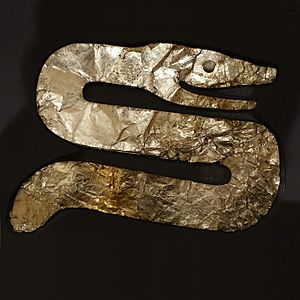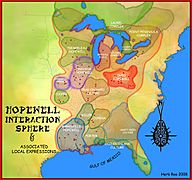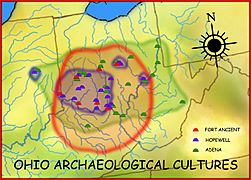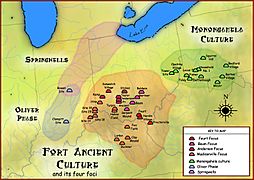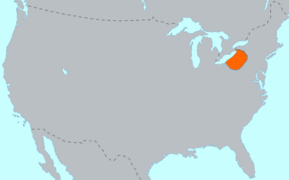Prehistory of Ohio facts for kids
The Prehistory of Ohio tells us about the amazing things that happened in Ohio long before written records. The first people in Ohio were ancient hunters called the Paleo-Indians. They lived here from about 13,000 B.C. to 7,000 B.C. These early people were hunter-gatherers. This means they hunted animals and gathered plants for food. They traveled widely to find large animals like mastodons. Scientists found mastodon bones at the Burning Tree Mastodon site. These bones showed that Paleo-Indians had hunted and prepared the animal. They used special tools called Clovis points. These tools show that they hunted big game and traded with other groups.
Later, during the Archaic period (8000 B.C. to 500 B.C.), the climate got warmer. People started living in one place for longer. They also made more advanced tools like spear-throwers. Some groups, like the Glacial Kame culture, traded for special items like seashells and copper. These items showed how important someone was in their group.
The Woodland period (800 B.C. to A.D. 1200) brought big changes. People began living in villages. They developed rich traditions and art. They also started building huge earthworks and mounds. Some mounds were used for burying people. While they still hunted and gathered, they also began to farm crops. The Adena culture and Hopewell tradition were important groups during this time. Villages grew larger and often had walls for protection.
In the Late Prehistoric period (A.D. 900 to 1650), villages became even bigger. They were often built on high ground near rivers. Many were surrounded by wooden fences called stockades. Earthworks were built again, but not as often as before. The Serpent Mound, the largest animal-shaped mound in the country, was built by the Fort Ancient culture. Maize (corn) became a main food, along with squash and beans. Village centers were used for important ceremonies.
The Early Contact period (1600–1750) began when Ohio tribes met Europeans. But Native Americans had already started getting European trade items. They traded for things like glass beads and copper. Direct contact began in the late 1600s when traders and settlers came to Ohio. Sadly, they also brought diseases like smallpox. These diseases were very dangerous for Native American tribes, especially children and older people.
Contents
Ohio's Ancient Landscape

Long, long ago, humans and animals traveled across a land bridge called the Bering Strait. This bridge connected Asia to North America. Over hundreds of years, they moved into what is now the United States. Animals like mastodons, mammoths, elk, bison, and caribou came from Asia. Some scientists think the first humans might have traveled through Canada. Then they moved south to the Great Lakes region and into Ohio. Thousands of years ago, the Great Lakes reached much further south than they do today.
Giant glaciers shaped Ohio's land. When they melted, they left behind bogs and small lakes. They also created the flat Erie Plain along the Lake Erie shore. The Glaciated Allegheny Plateau in southern Ohio had steep hills. Thousands of years ago, this area had thick forests of beech and maple trees. By the time Europeans arrived, the Erie Plain had wide river areas and marshes. It also had small prairies and mixed oak forests.
Paleo-Indian Period: The First Hunters
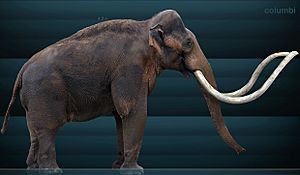
The Paleo-Indian period lasted from about 13,000 B.C. to 7,000 B.C. This was during the last part of the Ice age. The first people in Ohio came from those who crossed the Bering Strait land bridge. These Paleo-Indians were the earliest hunter-gatherers in Ohio. They ate food they hunted, fished, and gathered. They hunted huge animals like mammoths and mastodons, which are now extinct. They also hunted smaller animals like deer. Fish, fruits, and nuts were also part of their diet.
Bones from the Burning Tree Mastodon site show that Paleo-Indians hunted and prepared mastodons. Most of what we know about Paleo-Indians comes from finding their stone tools. The Burning Tree Mastodon site is one of the most important Paleo-Indian discoveries in Ohio.
Clovis Culture: Spear Point Masters

The Clovis culture (9500 to 8000 B.C.) is the earliest known Paleo-Indian group in Ohio. They are named after their unique spear points. These clovis points were first found near Clovis, New Mexico. The points were attached to spears for hunting. Scientists believe they were used to hunt mastodons and mammoths. Clovis people traveled across the land to find food. They lived in shelters made of wooden poles covered with animal hides or tree bark.
They made tools from flint, a very hard stone. They especially liked Flint Ridge flint from Licking County, Ohio and Upper Mercer flint from Coshocton County, Ohio. Flint was strong and could be shaped into very sharp edges. Their tools included scrapers, knives, and spear points.
Clovis people were free to move between groups. If someone was very good at healing or hunting, they earned respect. Older people were also respected for their wisdom. Most Native American people today are descended from the Clovis people.
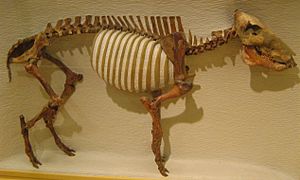
Evidence of Clovis people from about 13,000 years ago was found at the Paleo Crossing Site in Medina County, Ohio. This might be the oldest sign of human activity in Ohio. Small groups of hunters used this site to meet, share information, and plan big hunts. Scientists found charcoal from cooking pits there. They also found tools made from flint that came from Indiana, 500 miles away. This shows that these early hunters traveled far and had a wide network. The Nobles Pond Site in Stark County, Ohio was an even larger meeting place. It has many tools made from Ohio flint.
Other early sites include the Sandy Springs Site, Sheriden Cave, and the Welling Site.
Archaic Period: Adapting to a New Climate
Archaic people lived from 8000 B.C. to 500 B.C. The Ice Age had ended, and the climate was warmer. Forests were thicker, much like Ohio today with its four seasons. Archaic people used tools in more advanced ways. They still moved freely between groups. Over time, they started staying in one place for longer. They dug pits to store food and built stronger homes. They hunted turkeys, deer, and waterfowl. They also fished and gathered berries, acorns, and nuts. As the climate changed, different foods became available.
Archaeologists divide this period into Early and Middle Archaic cultures. Early Archaic groups were smaller. As the population grew, people lived in larger groups. In the Middle Archaic period, people found more types of food. Later in the Archaic period, people developed trade routes. This brought new goods and ideas, making groups more diverse.
Archaic people continued to make tools from flint. But they made a wider variety of tools than the Paleo-Indians. Early Archaic groups had many spear points. They also made large chert knives. These tools had different shapes for different uses. Some were like knives, others were for long spears. Middle Archaic groups made many tools. These included knives, grinding stones, scrapers, and net sinkers. They used mortars and pestles to grind foods like acorns and nuts.
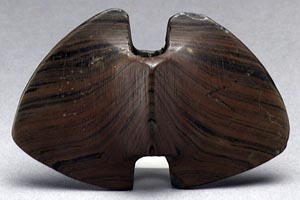
They invented spear-throwers, also called atlatls. These tools helped them throw spears with more force, accuracy, and distance. Bannerstones made of slate were attached to the atlatl shafts. They also made axes from granite. These axes were used to cut down trees and hollow out canoes or build houses. They carved and polished slate for decorations or weights. They also made jewelry and fishing weights by grinding stone. They set up base camps for the winter. An Archaic family might spend a day building a fire, fishing, grinding nuts, or carving a canoe.
The number of Archaic sites increased greatly in the last few thousand years of this period. This shows that the population grew. More stone tools were found from this time. These included drills, knives, scrapers, and tools for grinding food. Fishing tools like harpoon heads and bone hooks show they fished in Lake Erie and rivers. Beech-maple forests were common by then.
Important Archaic sites are found along the Maumee River and at places like Dupont Site and Raisch-Smith Site.
=Glacial Kame Culture: Traders of Prestige
The Glacial Kame culture was a Late Archaic group. They traded for seashells and copper with other groups. These items were very special. They showed that someone was important, like a respected healer or hunter. These special objects were often buried with their owners.
Post Archaic Period: Villages and Farming
Woodland Period: New Ways of Life
People of the Woodland Period (800 B.C. to A.D. 1200) lived in small villages. Their houses were more permanent. They started farming plants like sunflower, squash, and lamb's quarter. This was a big change from just hunting and gathering. They also began making pottery. They used burial mounds to bury their dead.
The Hopewell tradition and Adena culture built amazing earthworks. These were often in geometric shapes, like the Newark Earthworks. Other earthworks are found near Chillicothe at the Hopewell Culture National Historical Park. These groups also had rich artistic and ceremonial lives. They created art using materials they got through large trade networks.
During the Middle Woodland period, about 2,000 years ago, small villages were built in northeast Ohio. They were often by rivers, on high ridges with steep cliffs. This made them hard to reach. Some villages were also surrounded by ditches and earth walls for defense. Some sites were used for a long time, with signs of cooking pits and burials. The Adena and Hopewell cultures also had sites used only for ceremonies.
During the Woodland period, people started making pottery. Early pottery was carved from soapstone. Later, they used crushed granite rocks and clay from local rivers. They pressed fabric onto the wet clay before drying and firing the pots. The fabric marks show that people also made textiles, mats, and baskets. Pots were used to store food, protect it from animals, and cook over a fire.
The population grew quickly in the Late Woodland Period (A.D. 600 to A.D. 1200). People lived in larger, more permanent villages. They built defensive walls or ditches around their villages. This might have been because of more conflicts between villages. This period saw less focus on art and building large earthworks. People relied more on farmed food like sunflower and maize (corn), which they started growing around A.D. 800. Food was stored in large pottery jars.
Arrow points became smaller and thinner. They were used for hunting or as weapons. This time marked the end of the Hopewell culture. Different cultures started to develop in different areas. They stopped trading over long distances. The building of large earthworks mostly stopped.
Adena Culture: Early Mound Builders
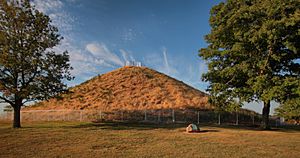
The Adena culture lived in southern Ohio and nearby states during the Early Woodland period. They were very artistic. They made pipes and earthworks for ceremonies. They created beautiful siltstone pipes and other items for their rituals and burials. They built earthworks like cone-shaped burial mounds and circular enclosures. These were some of the first earthworks in Ohio.
People in northern Ohio lived similarly to the Adena culture. But their earthworks were oval enclosures called forts. They also built walls along bluffs. They did not create large earthen mounds.
Hopewell Culture: Master Architects and Artists
The Hopewell tradition was centered in Ohio. It thrived during the Middle Woodland period. They are famous for their amazing buildings and art. They had a "complex ceremonial life" that was unmatched in North America at the time. They spent thousands of hours building huge geometric earthworks. These earthworks were carefully planned to fit the landscape. They might have even been lined up with the moon and stars.
They made goods from copper that came from hundreds of miles away. They created many artistic items. These included small figures, decorated pottery, animal-shaped pipes, copper plates, and mica cut-outs.
Famous Mounds of Ohio
| Mound | Location | Date | Culture | Notes |
|---|---|---|---|---|
| Conus | Marietta Earthworks, Marietta, Ohio | 100 BCE to 500 CE | Adena culture | This large cone-shaped mound is part of the Marietta Earthworks. |
| Dunns Pond Mound | Logan County, Ohio | ca. 300 to 500 CE | Ohio Hopewell culture | Located near Indian Lake, this mound was used as a burial site for many centuries. |
| Miamisburg Mound | Miamisburg, Ohio | 800 BCE to 100 CE | Adena culture | This is the largest cone-shaped mound in Ohio. It is 65 feet (20 m) tall. |
| Mound City | Chillicothe, Ohio | 200 BCE to 500 CE | Ohio Hopewell culture | This site has 23 earthen mounds. Each mound covered the remains of a special building. After people were cremated, the building was burned. Then a mound was built over the remains. Artifacts like copper figures and pipes were also placed in the mounds. |
| Newark Earthworks | Licking County, Ohio | The Newark Earthworks include the Octagon and Great Circle Earthworks. | ||
| Serpent Mound | Adams County, Ohio | This amazing snake-shaped mound is 1,330 feet (410 m) long. |
Late Prehistoric Period: Growing Villages
During the Late Prehistoric period (A.D. 900 to 1650), villages became larger. They were often built on high ground and surrounded by wooden fences. People lived in these villages from late spring to early fall. Some even lived there all year round, especially by 800 years ago. Open areas called plazas were in the center of villages. These plazas were used for rituals. In other parts of the country, like the Mississippi Valley, large cities grew. Cahokia in Illinois was the biggest city of this time. People were buried in animal-shaped mounds or in graves around the village plaza. The Alligator Effigy Mound and Serpent Mound might have been built to honor important spirits.
Maize (corn) became a main food. Squash and beans were also important crops. Hunting, fishing, and gathering wild plants still provided food. Villages usually had one or two leaders, sometimes a war chief. This period also saw changes in religious practices.
Several cultures were important during this time. These included the Monongahela culture, Whittlesey culture, Sandusky culture, and Fort Ancient cultures.
Whittlesey Culture: Fortified Villages
The Whittlesey culture has been studied a lot. Many sites like Fairport Harbor and South Park show their way of life. Scientists found evidence of house walls and pits for cooking and storage. They also found many artifacts like pottery and arrow points. Burned remains of squash, beans, and maize show that they farmed these foods. Bones and clam shells prove they continued to hunt and fish. Whittlesey villages were built with defense in mind. They were on hilltops and had stockades, ditches, or earth walls around them.
Fort Ancient Culture: Serpent Mound Builders
The Fort Ancient culture lived in southern Ohio and northern Kentucky during the Late Prehistoric Period. Their houses were rectangular or circular and surrounded a plaza. They did not build as many earthworks as the Hopewell culture. But they did build several large ones, like the Serpent Mound. This is the largest animal-shaped mound in the country. They also made petroglyphs, which are images carved into rock. The Leo Petroglyph has images of footprints, people, and animals. Their stone tools had unique shapes, like triangular arrow points.
Early Contact Period: Meeting Europeans
The Early Contact period (1600–1750) began when Ohio tribes met Europeans. But Native Americans had already started getting European trade items about a hundred years earlier. They got these items through trade with other Native American groups. They traded for glass beads, brass, and copper items from Europeans. They were also influenced by Spanish explorers from the south.
Direct contact began in the late 1600s. Traders, explorers, and settlers came to Ohio. The native peoples of Ohio had never been exposed to European diseases. They had no protection against illnesses like smallpox. This disease was very deadly for Native Americans, especially children and older people.
Conflicts between the Iroquois and the French led to the Iroquois expanding their land into Ohio. Around 350 years ago, the Whittlesey culture left Ohio. During the Beaver Wars, the Iroquois attacked other native groups. The Whittlesey people might have been victims of these attacks. By 1650, there were no native people living in northern Ohio. Other local groups were also forced out of the state. Many native people returned after the conflicts ended. Native American groups in Ohio included the Huron, Wyandot, Catawba, Miami, Delaware, Shawnedd, and Mingo.
In the 1800s, Native Americans were forced out of Ohio. They were moved westward across the Mississippi River.
Prehistoric Culture Maps
-
Fort Ancient culture
-
Nation du Chat (Erie people) region




